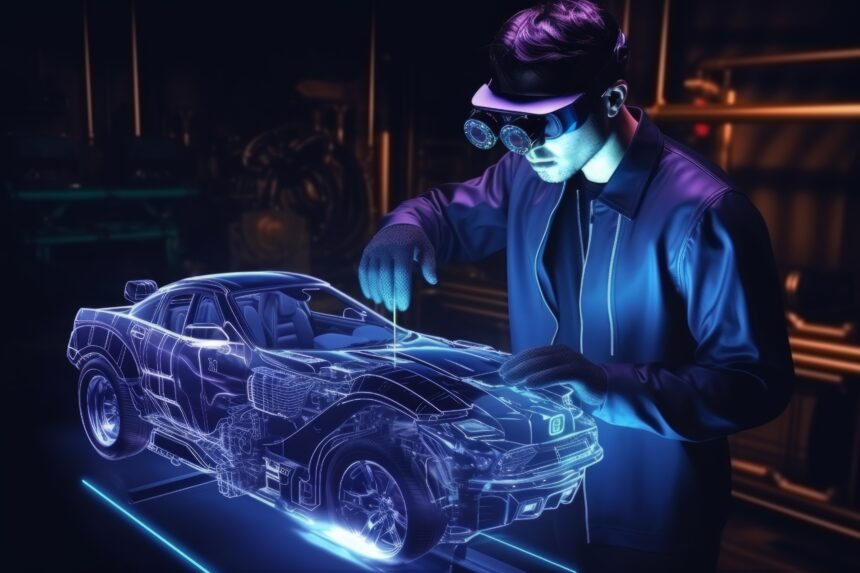Introduction
Artificial intelligence (AI) is driving a monumental shift in the automotive industry, reshaping the way vehicles are designed, manufactured, and operated. From autonomous driving to smart traffic management, AI-powered innovations are enhancing safety, efficiency, and overall driving experiences. The automotive sector is undergoing a digital transformation where machine learning, deep learning, and intelligent automation are revolutionizing traditional practices, making cars smarter and more capable.
As connected and self-driving vehicles become more prevalent, AI plays a pivotal role in enhancing vehicle performance and optimizing operations for manufacturers, fleet owners, and individual drivers. AI-powered automation is streamlining production processes, while predictive analytics is improving maintenance strategies. Moreover, AI-driven technologies are paving the way for safer roads, reducing traffic congestion, and minimizing human errors in driving. This article explores how AI is influencing every aspect of the automotive industry, the challenges it faces, and what the future holds for this technology-driven revolution.
AI in Vehicle Manufacturing
The impact of AI in car manufacturing is profound, improving production efficiency and ensuring better quality control. AI-powered automation has transformed factory operations, from assembling car parts to supply chain optimization. Robotics, powered by AI, have taken over repetitive tasks with unmatched precision, reducing costs and increasing production speed. AI helps manufacturers predict market demand, manage inventory efficiently, and minimize material waste.
One of the most significant advancements is AI-powered quality control. Machine learning algorithms analyze images and sensor data in real time to detect even the smallest defects in car parts. This reduces the chances of faulty components reaching the market, ensuring customer satisfaction and reducing recall costs. Additionally, AI-driven predictive maintenance for manufacturing machinery prevents unexpected breakdowns, minimizing downtime and improving operational efficiency. AI not only enhances manufacturing but also optimizes logistics, helping companies deliver vehicles faster and at lower costs.
Autonomous Vehicles: The Future of Driving
The dream of fully autonomous vehicles is becoming a reality, thanks to AI-driven technologies. Self-driving cars rely on deep learning, computer vision, and sensor fusion to perceive their surroundings, make decisions, and navigate safely. Companies such as Tesla, Waymo, and Uber are leading the development of autonomous vehicles, integrating AI with advanced sensors like Lidar, radar, and cameras to create a comprehensive 360-degree awareness of the road.
Autonomous vehicles are categorized into six levels of automation, ranging from Level 0 (no automation) to Level 5 (full autonomy). Currently, Level 2 and Level 3 automation, which include features like lane-keeping assistance and self-parking, are already available in commercial vehicles. However, Level 5 fully autonomous cars, which require no human intervention, are still in development and face technological and regulatory challenges.
Despite the advancements, self-driving technology must overcome obstacles such as unpredictable human behavior, regulatory approvals, and ethical considerations. AI systems must be trained to respond appropriately to real-world complexities, including mixed-traffic environments where human drivers and autonomous vehicles share the road. Nonetheless, AI is steadily making autonomous driving safer and more reliable, promising a future where self-driving cars will dominate urban mobility.
AI in Traffic Management and Safety
AI is not only transforming vehicles but also revolutionizing traffic management systems, making roads safer and more efficient. AI-powered smart traffic control systems analyze real-time data from sensors, cameras, and GPS to optimize signal timings and reduce congestion. By adapting to traffic patterns dynamically, these systems enhance road efficiency, lower fuel consumption, and minimize delays for commuters.
AI is also improving accident prediction and prevention by analyzing data on road conditions, driver behavior, and weather patterns. Advanced driver-assistance systems (ADAS) use AI to monitor vehicle movements, detect potential hazards, and provide alerts to prevent accidents. AI-driven emergency response systems analyze accident reports, assess the severity of incidents, and direct emergency services to the right locations, reducing response time and potentially saving lives.
Enhanced Driver Assistance Systems (ADAS)
AI has introduced various driver-assistance technologies that significantly enhance vehicle safety and driving comfort. One of the most widely used ADAS features is lane departure warning, where AI-powered cameras track lane markings and alert drivers if they drift unintentionally. Some systems even provide corrective steering assistance to prevent accidents.
Adaptive cruise control is another AI-driven feature that maintains a safe distance from the vehicle ahead by automatically adjusting speed based on traffic conditions. AI also powers automatic emergency braking systems, which detect obstacles and apply brakes when the driver fails to react in time. These safety features are reducing accidents and making roads safer for all users.
AI in Vehicle Diagnostics and Maintenance
AI-driven diagnostics and predictive maintenance are transforming the way vehicles are maintained and repaired. AI analyzes sensor data from various vehicle components to predict when parts like brakes, tires, and batteries will need replacement, preventing sudden breakdowns and reducing repair costs.
Modern cars come equipped with AI-powered diagnostic tools that provide real-time insights into engine performance, fuel efficiency, and emission levels. Fleet operators use AI to monitor vehicle health across multiple vehicles, ensuring timely servicing and minimizing downtime. AI is making car maintenance more proactive rather than reactive, increasing vehicle longevity and reducing operational costs.
AI-Powered In-Car Assistants
AI has brought intelligent virtual assistants into vehicles, making driving more interactive and convenient. AI-powered systems like Apple CarPlay, Google Assistant, and Amazon Alexa allow drivers to use voice commands for navigation, entertainment, and communication without distractions. AI-driven voice recognition has improved significantly, enabling drivers to control various car functions, such as adjusting the temperature, playing music, or making hands-free calls.
Personalized driving experiences are also enhanced through AI, as vehicles learn driver preferences and adjust seat positions, climate control, and driving modes accordingly. AI is turning vehicles into smart personal assistants, making journeys more comfortable and efficient.
AI in Car Design and Development
Car design is becoming more innovative with the help of AI. Generative design algorithms analyze vast datasets to optimize vehicle structures for better aerodynamics, weight reduction, and fuel efficiency. AI is also being used in crash simulations, allowing engineers to test vehicle safety digitally before physical prototypes are built.
AI enhances efficiency in design by suggesting improvements that can reduce production costs and enhance vehicle performance. Automakers are increasingly relying on AI to develop energy-efficient components that contribute to sustainable and eco-friendly transportation.
AI in Fleet Management
Fleet operators are leveraging AI to optimize operations, reduce costs, and improve efficiency. AI-powered route optimization systems analyze traffic conditions, weather data, and delivery schedules to determine the most efficient paths, saving fuel and reducing travel time. AI-driven fuel efficiency monitoring helps companies track consumption patterns, allowing them to implement strategies for reducing operational expenses and carbon emissions.
Predictive analytics play a crucial role in fleet management by identifying wear and tear on vehicles and ensuring timely maintenance. AI enables fleet operators to maximize vehicle lifespan and improve reliability, ultimately enhancing business profitability.
The Role of AI in Electric and Smart Vehicles
AI is instrumental in the development of electric vehicles (EVs) and smart cars. AI-driven battery management systems monitor battery health, predict potential failures, and optimize power distribution to extend driving range. Smart charging solutions help EV owners locate the nearest charging stations and schedule optimal charging times based on electricity rates, making electric mobility more convenient and efficient.
AI and Cybersecurity in Connected Cars
As vehicles become more connected, cybersecurity is a growing concern. AI-powered threat detection systems analyze network activity to identify and prevent hacking attempts. AI also secures vehicle-to-vehicle communication, ensuring safe data exchanges and protecting against cyber threats. Data privacy is another crucial aspect, and AI ensures that personal information collected by smart vehicles is securely stored and used responsibly.
Future of AI in the Automotive Industry
The future of AI in the automotive sector is filled with exciting possibilities. AI will continue to advance autonomous driving technology, improve traffic management, and enhance vehicle safety. AI-powered solutions like hyperloop transport and drone taxis could redefine urban mobility, making transportation faster and more efficient. AI will drive greater automation in manufacturing, making car production more cost-effective and sustainable.
Conclusion
Artificial intelligence is reshaping the automotive industry at every level, from manufacturing and vehicle design to autonomous driving and smart traffic management. While challenges such as ethical considerations and regulatory hurdles persist, AI continues to push the boundaries of what’s possible in transportation. The future promises even greater advancements, ensuring that vehicles become safer, smarter, and more efficient than ever before.






